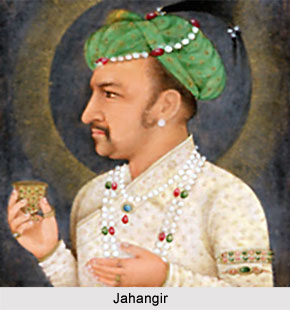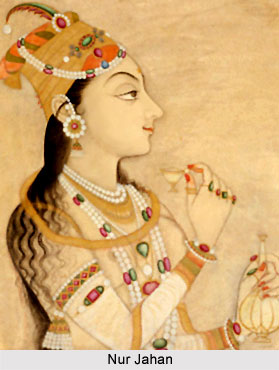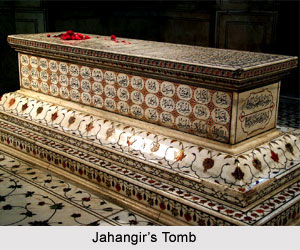 Jahangir
Jahangir
Jahangir, the Mughal Emperor, born in the year 1569, succeeded to the throne a week after the death of his father Akbar. The coronation of Salim took place in November 1605 A.D. and he assumed the title of Nur-ud-din Muhammad Jahangir. Like Akbar, Jahangir managed diplomatic relations on the Indian subcontinent dexterously, was tolerant of non-Muslims, and was a great patron of the art. He was greatly assisted by his wife Nur Jahan in administrative affairs. Jahangir began his reign with the declaration of many liberal laws which benefited his subjects. Jahangir was a just and kind ruler. He was also a fairly obedient son, a lovable father, and a good relative. He certainly revolted against his father but it was more due to his intention to behave as an independent individual rather than the desire to capture the throne of his father. Jahangir also possessed some weaknesses. He was easily influenced by his close relatives. His revolt against his father was also more due to their evil influences than his personal ambitions. His same weakness was responsible for his handing over the reins of government in the hands of his beloved queen, Nur Jahan.
Early Life and Education
Jahangir, whose birth name was Mirza Nur-ud-Din Muhammad Salim, was the third son of Akbar and Mariam-uz-Zamani. He was named after the Indian Sufi saint, Salim Chishti. His mother had sought the blessings of Salim Chishti for the birth of a son, and Jahangir`s birth brought great joy to Akbar. He grew up fluent in Persian and premodern Urdu and received education in various subjects, including strategic reasoning and military warfare.
Expansion of Empire by Jahangir
Jahangir pursued the policy of the extension of the empire like his father. The conquest of north India was nearly complete during the reign of Akbar. Only a few petty states and Mewar in Rajasthan could maintain their independence. Jahangir tried to subdue Mewar and the states in south India. Jahangir desired the submission of Mewar from the beginning of his reign and dispatched prince Parwez to conquer Mewar after his accession to the throne in 1605 A.D. Ultimately the Rana accepted the suzerainty of the Mughal emperor and a peace treaty was signed between the Mughals and the Rana in 1615 A.D. Thus the long-drawn war between Mewar and the Mughals ended.
Jahangir tried to complete the conquest of south India. Khandesh and a part of Ahmednagar were conquered during Jahangir`s reign. But the conquest of Ahmednagar could not be completed while Golkonda and Bijapur were left untouched so far. Jahangir attempted to conquer them. The campaigns of the Mughals in the Deccan during the reign of Jahangir, infact brought not much territorial gain though of course, pressure on the states of south India were increased. No rulers of the south were prepared to acknowledge the suzerainty of the Mughals.
Foreign Relations and Expansion
Jahangir was also involved in foreign relations and expansion of the Mughal Empire. The East India Company sent Sir Thomas Roe as a royal envoy to Jahangir`s court, leading to the establishment of an East India Company factory in Surat. While no major trading privileges were conceded, this marked the beginning of a relationship that would develop into something approaching a partnership between the Mughals and the East India Company.
Jahangir pursued the policy of expanding the empire, following in the footsteps of his father. He aimed to subdue Mewar and the states in south India, but while some conquests were made, the rulers of the south did not acknowledge the suzerainty of the Mughals.
Reign and Challenges
His reign was not without challenges, as his own son, Prince Khusrau Mirza, attempted to claim the throne based on Akbar`s will. Jahangir managed to defeat his son, who was subsequently imprisoned. Jahangir considered his third son, Prince Khurram (later known as Shah Jahan), as his favorite. However, political turmoil ensued when Nur Jahan, Jahangir`s wife, married her daughter to Jahangir`s youngest son, Shahryar Mirza. Khurram saw this as a plot to make Shahryar the successor to Jahangir, leading him to rebel against his father. The rebellion ended in 1625 after a series of victories by Mahabat Khan over Khurram.
Conquests of Jahangir
Jahangir was well trained in arms and was an expert rider. But he was not prepared to undergo hardships of battlefield. He did not participate in any major battle during the reign of his father and, during his own reign all important battles were fought either under the command of his son Shah Jahan or under other talented officers. Jahangir neither tried to improve the military system which he inherited from his father nor increased the fighting strength of his army in any way. As regards religious beliefs and policy, Jahangir stands midway between his father, Akbar and his son, Shah Jahan. He believed in God and normally pursued the basic principles of Islam.
Jahangir`s reign was a period of cultural and artistic flourishing, with his court attracting poets, artists, and scholars. His memoir, Tuzuk-i-Jah narrates the establishment of the "Chain of Justice" where petitioners could get his direct attention of any issue.
Marriages of Jahangir
Jahangir had a remarkable and extensive history of marriages. These marriages, which took place during the late 16th and early 17th centuries, played a significant role in shaping Jahangir`s personal life and his reign as the fourth Mughal Emperor.
Salim`s first wife was Shah Begum, the daughter of his maternal uncle Raja Bhagwant Das. Betrothed at a young age, their marriage took place in 1585, and Salim`s Mansab, a rank in the Mughal administrative system, was raised to Twelve Thousand to commemorate the occasion. Shah Begum was highly regarded as a suitable princess for Salim, described by Abul Fazl in Akbarnama as a paragon of virtue and extraordinary beauty.
Shortly after, Salim married Man Bai, a Rajput princess and the daughter of Raja Udai Singh Rathore of Marwar. The marriage ceremony was held in 1585, in Amer, the native town of Salim`s mother, Mariam-uz-Zamani. Another notable wife of Salim was Jagat Gosain, also known as Manavati Bai, who hailed from the prestigious Rajput lineage of Raja Udai Singh Rathore. Their marriage took place in 1586, and Jagat Gosain later gave birth to Prince Khurram, who went on to become the renowned Emperor Shah Jahan.
Salim`s matrimonial alliances extended beyond Rajput princesses. In 1586, he married a daughter of Raja Rai Singh, the Maharaja of Bikaner. In addition, he wedded Malika Shikar Begum, the daughter of Abu Sa`id Khan Chagatai, and Sahib-i-Jamal Begum, the daughter of Khwaja Hassan of Herat, who was a cousin of Zain Khan Koka. These alliances solidified connections with various regions and families across the Mughal Empire.
In 1587, he married Malika Jahan Begum, the daughter of Bhim Singh, the Maharaja of Jaisalmer, and the daughter of Raja Darya Malbhas. In 1590, he married Zohra Begum, the daughter of Mirza Sanjar Hazara, and Karamsi, the daughter of Raja Kesho Das Rathore of Merta. His marriage to Kanwal Rani, the daughter of Ali Sher Khan, took place in 1592. Jahangir also wedded a daughter of Husain Chak of Kashmir in 1592, and Nur un-Nisa Begum, the daughter of Ibrahim Husain Mirza, in 1593. Furthermore, he married a daughter of Ali Khan Faruqi, the Raja of Khandesh, and a daughter of Abdullah Khan Baluch.
In 1596, Salim married Khas Mahal Begum, the daughter of Zain Khan Koka, who held the position of Subadar of Kabul and Lahore. In 1608, Salim married Saliha Banu Begum, the daughter of Qasim Khan, a senior member of the Imperial Household. Saliha Banu Begum held the esteemed title of Padshah Begum and retained this title for most of Jahangir`s reign. After her passing, the title was passed on to Nur Jahan, who would become one of Jahangir`s most influential wives.
In 1608, Jahangir married Koka Kumari Begum, the eldest daughter of Jagat Singh, the Yuvraj of Amber. Additionally in 1610, he married the daughter of Ram Chand Bundela, expanding his matrimonial alliances even further.
Among Jahangir`s numerous wives, one notable consort was the daughter of Mirza Muhammad Hakim, the son of Emperor Humayun. This particular wife held a prominent position as one of Jahangir`s chief consorts, and her influence within the imperial harem was significant. However, one of Jahangir`s most renowned and influential wives was Mehr-un-Nissa, later known as Nur Jahan.
 Nur Jahan, Wife of Jahangir
Nur Jahan, Wife of Jahangir
Jahangir married Mehr-un-Nissam later called “Nur Jahan†(light of the world) in 1611 and she was previously the widow of Sher Afgan. Nur Jahan played an instrumental role in Jahangir`s reign, wielding considerable political power and influencing important decisions of the empire. Nur Jahan was an educated, social, generous, intelligent and cultured lady and was fond of poetry, music and painting. She was interested in administration and had the capacity to tackle the relevant problems. She participated in administration, interfered in the politics of her time, increased her influence and tried to keep the power of the state in her hands. Therefore, she influenced the history and politics of during Jahangir`s reign.
In 1613 A.D. Nur Jahan was elevated to the rank of Badshah Begum or the first lady of the realm. Nur Jahan`s tremendous influence was the cause of disappointment among certain Mughal nobles, like Mohabbat Khan, and Jahanghir`s son Prince Khurram, who struggled his way to the throne. Nur Jahan voted for Shariyar, another son of Jahangir as the next ruler. Her hostility propelled Prince Khurram to revolt in 1622.This revolt snatched away Kandahar from the Mughal Empire. Thus, the interference of Nur Jahan in the politics of the state resulted in two major rebellions during the last years of the reign of Jahangir which weakened the empire and harmed its prestige.
Development of Art and Culture
Jahangir was a well-educated and cultured person. He had good command over Persian and Turki language and was well-versed in other languages as well like Hindi and Arabic. He wrote his autobiography entitled Tuzuk-i-Jahangiri himself for seventeen year and later on got it prepared by others under his personal guidance. The description is fairly creditable and proves that Jahangir had not only varied interests but also knowledge of different subjects and fine arts. Jahangir was keenly interested in painting which reached to its zenith of progress during his rule.
Development of Architecture
Jahangir was interested in architecture as well. The tomb of Akbar at Sikandrabad near Agra was constructed by him and it is one among the beautiful buildings erected by the Mughal emperors. The mosque in Lahore, which was constructed in his reign, has been compared with the Jami Masjid, constructed by Shah Jahan, in Delhi. One of the most striking buildings constructed during his sovereignty, is the tomb of Itimad-ud-daula near Agra, which was constructed by Nur Jahan. Jahangir laid out many beautiful gardens in Kashmir and Lahore.
Legacy and Personal Life
Jahangir is famous for his "Chain of Justice," which allowed his subjects to appeal to him if they were denied justice at any level. He was known for his tolerance of non-Muslims and his patronage of the arts. Jahangir had multiple marriages, including with Shah Begum, Manavati Bai, and Nur Jahan, who played a significant role in administrative affairs. He had a complicated relationship with his sons, with Prince Khurram eventually succeeding him as Emperor Shah Jahan.
 Death of Jahangir
Death of Jahangir
Jahangir, known for his indulgence in opium and wine, experienced frequent bouts of illness during the 1620s. Seeking to restore his health, he embarked on journeys to Kashmir and Kabul. However, due to a severe cold, he decided to return to Lahore.
Tragically, while traveling from Kashmir to Lahore, Jahangir passed away near Bhimber in October, 1627. In order to preserve his body, the internal organs were removed and buried within Baghsar Fort near Bhimber, Kashmir. The remains were then transported by palanquin to Lahore, where they were interred in Shahdara Bagh, a suburb of the city. The construction of Jahangir`s tomb was commissioned by his son, Shah Jahan. His tomb is currently a popular tourist attraction.
Jahangir`s demise triggered a minor succession crisis. Nur Jahan, his influential wife, supported her son-in-law, Shahryar Mirza, as the heir to the throne. Her brother, Abu`l-Hassan Asaf Khan, in a bid to counter Nur Jahan`s influence, installed Dawar Bakhsh as a puppet ruler and confined Nur Jahan in Shahdara. Upon Prince Khurram`s arrival in Agra in February 1628, he executed both Shahryar and Dawar, to claim his power to the throne. He adopted the name Shihab-ud-Din Muhammad Khurram, popularly known as Shah Jahan, began his reign as the fifth Mughal Emperor.



















